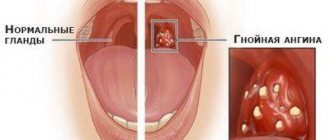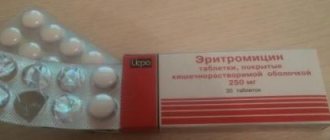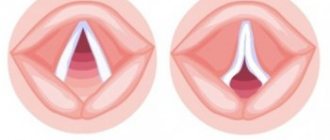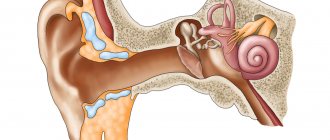Author's rating
Author of the article
Shutofedova Ksenia Yurievna
General practitioner
Articles written
578
about the author
The most severe variant of tonsillitis is necrotizing tonsillitis (Simanovsky-Plount-Vincent). This disease occurs very rarely. The main difference between this disease and other types of tonsillitis is the development of necrotic processes in the parenchyma of the tonsils, as well as an infrequent increase in general body temperature.
Causes of ulcerative necrotizing tonsillitis
The main causative agents of the disease are spindle-shaped bacteria and spirochetes. Less commonly, pathology manifests itself due to the effect on the mucous membranes of pathogenic agents such as staphylococci and streptococci. Such microorganisms constantly live in the human oral cavity, but do not cause the development of disease. Pathology begins to manifest itself when the body’s protective function decreases. Experts call the following conditions provoking factors due to which ulcerative-necrotic (or gangrenous) tonsillitis develops:
- deficiency of minerals and vitamins in the diet;
- inflammation of the throat with a chronic course (tonsillitis);
- cachexia;
- weakening of the immune system;
- excess of vitamins B and C;
- foci of infection in the gastrointestinal tract;
- dystrophy;
- recurrent pharyngitis;
- allergic reactions;
- stomatitis;
- gingivitis;
- periodontal disease;
- failure to comply with oral hygiene rules;
- presence of purulent discharge in the throat.
The necrotic form of tonsillitis quite often becomes a complication of some serious diseases. Among them are oncological processes of the blood (for example, acute leukemia), infectious diseases (scarlet fever, diphtheria, tularemia). Necrosis of the tonsils when the pathological process is neglected spreads to the tissues of the larynx, sometimes the tongue, periosteum, and soft palate.
What is the disease
Simanovsky-Plaut-Vincent tonsillitis is also called ulcerative membranous tonsillitis. For the first time, the domestic otolaryngologist N.P. Simanovsky spoke about this disease. Further, French colleagues - doctors Plaut and Vincent - were able to identify the causative agent of the disease. According to clinical studies, this pathogen is found in the body of almost every person, but not everyone shows signs of the disease. Under the influence of a number of factors, the pathogen begins to actively multiply and become more active, which provokes the development of inflammatory processes in the mucous membrane of the throat. In 90% of cases, streptococci and staphylococci are involved in the primary pathological process, which intensifies the clinical picture of the disease, worsens a person’s well-being, and increases the risk of complications.
Ulcerative membranous tonsillitis affects not only the tonsils, but also the palatine arches and the soft palate. It happens that the disease affects only one tonsil and neighboring tissues of the throat and oral cavity. The tonsil increases in size, a grayish-yellow coating with an unpleasant odor appears on it, which is easily removed with a spatula. After its removal, bleeding ulcers with uneven edges and a loose bottom become visible on the mucous membrane.
Simanovsky-Plaut-Vincent sore throat can easily be confused with other diseases, in particular diphtheria, so it is very important to contact a qualified ENT specialist at the first signs of the disease, who can recognize the disease and prescribe adequate treatment.
Symptoms of necrotic inflammation
Membranous tonsillitis has its own characteristic clinical manifestations. The patient will complain of pain when swallowing. The intensity of this symptom increases if a secondary infection occurs. A sore throat is the first sign of the onset of a pathological process.
The disease is most characterized by unilateral tissue damage to the tonsils and pharynx. The occurrence of more widespread structural changes is observed less frequently. Patients complain of discomfort in the throat. It manifests itself as a sensation of having a lump that cannot be coughed up or swallowed.
The ulcerative membranous form of tonsillitis also has nonspecific symptoms. Purulent-necrotic tonsillitis is accompanied by an increase in the size of regional lymph nodes (cervical, occipital, submandibular). Common manifestations of the disease include intoxication syndrome. It includes increased body temperature (maximum up to 37.5 degrees, but in most cases it is normal), headache, lethargy, and decreased performance. Unpleasant (purulent) odor from the mouth, increased salivation (salivation) and dehydration are often observed with angina. Depending on the clinical manifestations, the doctor decides how to treat the patient symptomatically.
As the disease progresses, plaque forms in the throat and tonsils. In this case, the walls of the pharynx and tonsils are covered with a loose film. It is easily separated by mechanical impact or coughing. When the plaque detaches from the tissue, a small bleeding ulcer is formed, which has jagged edges.
How does the disease progress?
The name ulcerative-necrotizing tonsillitis comes from the word “necrosis” (death). This means that the advanced stage of the disease is characterized by necrosis of the tissues of the tonsils, and in especially severe cases, the walls of the larynx, tongue, palate and periosteum.
The symptoms by which the disease can be identified differ from those of acute bacterial or viral tonsillitis: body temperature remains within normal limits, and if it increases, it is only slightly (up to 37‑37.5 ºC). The patient is concerned about:
- slight pain when swallowing, which may intensify if a streptococcal or staphylococcal infection is associated with the disease;
- enlarged lymph nodes;
- discomfort in the throat, which feels like the presence of a foreign body in it that cannot be swallowed or coughed up;
- increased salivation;
- intoxication and dehydration.
How to gargle with soda and salt for a sore throat is described in this article.
Necrotizing tonsillitis is often accompanied by an unpleasant odor of rotten breath and stomatitis. Upon examination, the otolaryngologist discovers an enlarged, loose tonsil, covered with a white coating with a grayish or yellowish tint. If you touch it with a spatula, it easily separates from the tonsil tissue, leaving behind slight bleeding and a depression with jagged edges. Laboratory analysis of plaque (culture on a nutrient medium, antigen test, polymer chain reaction analysis) and the discrepancy between general and local symptoms, namely the patient’s working condition with severe tissue damage, helps the doctor make a final verdict. A general blood test shows an increased content of leukocytes and an increase in ESR.
What are the symptoms of a sore throat without fever is indicated in this article.
The disease most often affects one tonsil, but in rare cases it can be bilateral. The doctor’s initial task during diagnosis is to exclude a malignant tumor, tuberculosis, diphtheria, syphilis, and lacunar tonsillitis.
In the photo - ulcerative necrotizing tonsillitis:
If the body temperature rises above 37.5 ºC, this indicates the addition of a viral infection (staphylococcal or streptococcal) and requires appropriate adjustment of treatment.
You can learn how to use a local antibiotic for sore throat by reading this article.
Diagnostics
For adequate therapy it is necessary to make an accurate diagnosis. The diagnostic process includes questioning the patient (collecting complaints, medical history), examination and conducting laboratory and instrumental examinations.
Having examined the patient visually and by palpation, the doctor determines the enlargement and pain of the lymph nodes, the presence of yellow or gray plaque on the tonsils (signs of necrosis, or necrosis, of areas of the mucous membrane), tongue, and on the walls of the pharynx. At the initial stages of development of the ulcerative type of sore throat, the changes are superficial.
As the disease progresses, the damage spreads deep into the tissues of the tonsils, larynx, and tongue.
During a visual examination of the patient's pharynx, hyperemia (redness) of the tonsils and throat walls is determined.
For purulent-necrotic type of sore throat, the following laboratory tests are carried out:
- General clinical blood test.
- Bacterial culture to determine microflora.
- Antigen test.
- Polymerase chain reaction.
- Determination of the sensitivity of pathogens to antibiotic drugs.
It is also necessary to carry out differential diagnosis to exclude the development of diphtheria, cancer, and lacunar tonsillitis. In addition, it is important to distinguish necrotizing tonsillitis from syphilis and tuberculosis.
A general blood test shows changes in the level of leukocytes (increase) and an increase in the erythrocyte sedimentation rate. Rapid antigen testing is necessary for the detection of Beta-hemolytic streptococcus. The polymerase chain reaction allows you to identify the pathogen by particles of nucleic acid - DNA. When sowing, it is possible to determine which drugs are best to treat the patient in order to eliminate the ulcerative-necrotic form of tonsillitis.
Symptoms and diagnosis
The main diagnostic parameter for the course of ulcerative-necrotizing tonsillitis is the absence of temperature, and other symptoms often do not differ from other types of tonsillitis.
This type of sore throat: pharyngoscopic principles:
- Under the fibrous membrane, tissues that are affected by necrosis are visible (this phenomenon can be seen in the photo below).
- As a rule, necrotic changes occur on the surface of only one tonsil, as can be seen in the photo.
- Often, the bottom of the formed erosion is covered with a fibrous membrane, as shown in the photo.
In addition, there are symptoms such as:
- feeling of a foreign element in the throat;
- smell of rot from the mouth;
- difficulty swallowing;
- profuse salivation.
If such symptoms are supplemented by an increase in temperature, this indicates that the form of the disease is advanced and complications may have developed.
Associated symptoms are enlargement of the postauricular and submandibular lymph nodes, which hurt during palpation. When performing pharyngoscopy, a green and gray-yellowish coating is visible on the tonsils (as in the photo). If the plaque is not removed, then a bleeding wound appears.
At the initial stage of development of a sore throat without fever, pain is practically not felt, since the ulcer has not had time to penetrate deep into the tissue.
As it progresses, in particular when there is no treatment, the ulcer becomes crater-shaped and actively spreads to other areas - the tongue, gums, as can be seen in the photo. During this period, symptoms such as pain that occurs during swallowing appear.
To clarify the diagnosis, in addition to pharyngoscopy and the initial examination, a general blood test is performed, which reveals ESR and a high white blood cell count.
In order to exclude the presence of acute infectious diseases whose symptoms are similar (scarlet fever, diphtheria), a bacterial analysis of a throat smear is done.
Treatment of purulent-necrotic tonsillitis
Therapy for ulcerative membranous inflammation of the tonsils includes both systemic and local therapeutic measures. This combination treatment is necessary to prevent the development of complications of the disease. Diet is also important.
Drug treatment is intended to eliminate symptoms and the etiological factor. Symptomatic therapy includes taking pills for headaches (for example, Analgin, Paracetamol, Aspirin). To eliminate the cause of necrotizing tonsillitis, antibiotic drugs are used. The necessary medications are selected by the attending doctor after bacteriological culture. Agents to which the pathogen is not sensitive cannot be used. This is due not only to the lack of effect, but also to the risk of developing microflora resistance to antibiotics.
Groups of drugs that are used to treat necrotizing tonsillitis:
- Macrolides (“Azithromcin”, “Midecamycin”, “Erythromycin”, “Clarithromycin”).
- Penicillins (“Phenoxymethylpenicillin”, “Benzylpenicillin”, “Amoxicillin”).
- Cephalosporins (Cephylaxin, Ceftriaxone, Cefuroxime, Cefepime, Cefotaxime).
Most often, doctors recommend using drugs from the macrolide group. This is due to its high efficiency and minimal effect on the mucous membrane of the gastrointestinal tract. The bacteriostatic effect of the drugs helps not only to eliminate pathogenic microflora, but also to block the proliferation of individual bacteria that could survive.
For a quick recovery, you need to follow a diet. The diet includes foods rich in animal protein. These dishes include:
- poultry meat, as well as beef, rabbit;
- liver;
- cottage cheese;
- kefir, yogurt;
- eggs.
It is useful to eat foods rich in vitamins. Among them are fresh vegetables and fruits. You can prepare delicious drinks containing vitamin C from rose hips, viburnum, and cranberries.
When treating a necrotic form of tonsillitis, foods that cause irritation of the mucous membrane are excluded from the diet. This is hot or too cold food. It is not recommended to eat solid food, as it can mechanically damage the affected tissues. The patient should not eat spicy, salty, or very spicy foods.
Treatment of necrotizing tonsillitis
Treatment of this type of sore throat should occur exclusively in a hospital under the supervision of medical staff. Antibiotics in the complex therapy of necrotic form are prescribed only if local treatment does not help and the patient becomes worse. The main methods used are: rinsing, lubricating the mucous membrane and diet. In case of a complex course or an advanced form, surgical intervention may be indicated - opening the abscess or removing the tonsils.
Physiotherapy
Various types of physiotherapeutic techniques are used to restore and normalize blood circulation in the tonsils and lymphatic system. Physiotherapy helps relieve swelling, reduce the number of pathogens and thereby improve the overall course of the disease and speed up recovery.
As a complex therapy for the necrotic form of tonsillitis, the following is used:
- wave ultrasound;
- dry heat equipment: laser, ultraviolet;
- magnetotherapy.
Physiotherapy for necrotizing tonsillitis does not involve the administration of any medications!
Rinsing and irrigation
Patients are prescribed a course of rinsing using:
- hydrogen peroxide 3% - 1 tbsp. for one glass of warm water;
- furatsilina - 1 pill per 100 ml of water;
- "Miramistin" - in its pure form;
- salt and soda - 1 tsp each. for 250 ml of warm water.
To irrigate the oral cavity in a hospital, they usually use:
- silver nitrate;
- "Novarsenol" solution;
- potassium permanganate;
- potassium chloride;
- sprays - “Tantum Verde”, “Hexoral”, “Lugol”.
Lubricating the mucous membranes of the tonsils
Patients with this form of sore throat are recommended to lubricate the affected mucosal surface with an antiseptic hydrosolution: iodine, Lugol, chlorophyllipt 10%.
Pills
For angina, antibacterial therapy is prescribed with a number of drugs: cephalosporins, macrolides, penicillins.
Antibiotics such as:
- "Cephalexin"
- "Amoxicillin"
- "Cefazolin"
- "Benzylpenicillin"
- "Cefaloridin"
- "Phenoxymethylpenicillin."
Macrolides, unlike the drugs described above, have much fewer side effects. They have virtually no effect on the central nervous system and gastrointestinal tract and are less toxic to the body as a whole.
The most popular macrolides:
- "Midecamycin"
- "Leukomycin"
- "Azithromycin"
- "Erythromycin"
- "Clarithromycin."
Abscess incision
A peritonsillar abscess forms in the oral cavity in case of complications of the disease.
A purulent formation appears on the affected area and provokes:
- the appearance of pain;
- difficulty swallowing;
- red throat.
A few days after the first symptoms, the patient’s lymph nodes become significantly enlarged, the tongue swells, the head begins to hurt, and all signs of intoxication of the body appear. As a rule, an abscess is always accompanied by fever.
The abscess is incised in a hospital setting. First, the doctor makes an incision on the affected area. Then a special tool is inserted into it, expanding the incision and tearing its bridges. If the state of suppuration allows, all liquid is pumped out of it. Sometimes, after opening the formation, its walls stick together, and the wound has to be drained. This procedure can take from 2 to 5 days.
Tonsil removal
Excision of the tonsils is the most radical way to solve the problem. As a rule, the attending physician and surgeon recommend that patients have two tonsils removed at once. Such an operation certainly reduces the risk of developing a sore throat in the future. However, it does not completely exclude it. In addition to the tonsils located near the throat, there are also small tonsils, which can also become inflamed and lead to a necrotic form of sore throat.
Surgery to remove tonsils is not performed without the use of anesthesia. As a rule, local anesthesia does not give the desired effect, and the patient may experience quite unpleasant feelings during the operation. Therefore, surgery is recommended to be performed only under general anesthesia.
Diet
During necrotizing tonsillitis, you should not eat food that can irritate the already inflamed mucous membrane. It is necessary to exclude too hard, cold or very hot foods from the patient’s diet. During illness, you should not eat spicy, hot, or salty foods. But kefir, any fermented milk products, cheese and hard-boiled eggs can make up an excellent menu.
Dietary recommendations:
- exclude sweets and sugar from the diet;
- eat soft, liquid dishes, salads, soups, lean boiled meat;
- strictly prohibited - alcohol, soda;
- allowed - compotes, berry fruit drinks, teas, juices, warm milk;
- You can eat honey in small quantities and diluted form.
Treatment with folk remedies at home
The folk medicine cabinet contains many recipes that can be used as additional therapy during drug treatment.
Be sure to consult your doctor. Some products should not be used by people prone to allergic reactions. Remember, treating a sore throat exclusively with folk remedies is categorically unacceptable! Without adequate therapy, which only a doctor can prescribe, you risk serious complications.
Sage
A decoction of sage quickly and effectively relieves inflammation and reduces pain. This medicinal collection is sold in almost any pharmacy. It is better to buy a packaged collection. After brewing one sachet in a liter of boiling water, cover the resulting solution with a lid and let stand for several hours. The product should be used as a rinse - 3 times a day until symptoms disappear.
Aloe
This recipe can be used only after the ulcers in the mouth have begun to heal. Cut off a few large aloe leaves. Squeeze the juice out of them. Add one teaspoon of juice to 250 ml of boiled water. Gargle with the solution 2 times a day until recovery. In one rinse cycle, you need to use the entire portion - 1 glass. The product should be prepared only immediately before the rinsing procedure. The squeezed juice for later use should be stored in the refrigerator for no more than two days.
Onions with garlic
Squeeze the juice from one head of garlic and one onion. Mix everything into a single substance. Soak a tampon in it and treat the affected area 2 times a day for a week.
Milk with garlic
Grind one head of garlic to the consistency of small cubes. Mix garlic chips with milk - 300 ml. Bring the substance to a boil, cool. Take the drink orally 2-3 times a day, 1-2 tbsp. Treatment duration is 1 week.
Saline solution
Add 1 tbsp to one full-size glass. iodized sea salt. Gargle with the solution every 3-4 hours until complete recovery.
Eucalyptus
Take dry eucalyptus leaves. Grind the raw materials in the amount of one tablespoon. Pour the mixture with 1 cup of boiling water. Leave to brew overnight. Thoroughly rinse the inflamed area with the resulting product 3-4 times a day. This recipe can be used absolutely safely until complete recovery. Eucalyptus has a strong antiseptic effect, promotes tissue restoration and regeneration.
Calendula
The recipe with calendula can be used by both children and adults. Take a collection of dried calendula flowers in a volume of 1 tablespoon. Add the inflorescences to a vessel with hot water - 400 ml. Leave for 5-8 minutes. Bring the mixture to readiness in a water bath for 15 minutes. Strain the resulting solution and cool until warm. Rinse the tonsil area with calendula decoction 3-4 times a day. Treatment can be continued until complete recovery.
All ingredients for preparing gargles or herbal infusions can be purchased at the pharmacy. When purchasing herbs at a pharmacy, you can be sure not only of their composition, but also that all dried flowers have undergone careful selection and processing before packaging.
Recommendations
A patient with necrotizing tonsillitis should follow the most gentle, pastel regimen. His diet should include food enriched with vitamins and microelements. All dishes should be warm and semi-liquid. Such measures will help avoid unnecessary trauma to the mucous membrane.
Basic recommendations:
- drinking plenty of water;
- minimum physical activity;
- consumption of vitamin C;
- isolation of the patient in a separate room;
- daily wet cleaning of the room, ventilation;
- The sick person must have separate utensils and personal hygiene products.
If you are sick, it is strictly forbidden to go to work! Suffering an infection on your feet is a direct path to serious complications and long rehabilitation.
Local treatment
In addition to the use of antibiotic drugs, rinsing and wiping the tonsils with medicinal solutions are highly effective. Before starting such procedures, it is necessary to remove the film from the affected surface using a spatula. Then it is necessary to treat the resulting ulcerative defects of the mucous membrane. To do this, use solutions of the following:
- Hydrogen peroxide.
- Potassium chloride.
- "Furacilina".
- Potassium salt of permanganic acid.
Rubbing the tonsils with these medications should be done up to five times a day. In addition, it is recommended to treat the tonsils and affected areas of the pharynx with ulcers with Lugol's iodine solution and tincture of chlorophyllipt.
For rinsing, as for wiping, it is necessary to dilute hydrogen peroxide in the ratio of 2 tablespoons of the product per 200 milliliters of clean boiled water. The medicine with potassium permanganate is prepared in such a way that the concentration of the active substance is 0.1%. In addition, a weak solution of silver nitrate can be used for rinsing.
Folk remedies are also quite effective in local therapy. Decoctions of the following medicinal plants are widely used:
- sage;
- oak (bark is used);
- mint;
- viburnum (use both leaves and young branches);
- St. John's wort;
- daisies.
To prepare the product, you need to boil them for about 15 minutes in a steam bath. Then the broth should brew and cool for forty minutes. For medicine, you can take either one plant from the list or several.
A saline solution is considered effective. You can also add a teaspoon of baking soda and a drop of iodine to it. This will enhance the effect of sea salt on pathogenic bacteria and contribute to the rapid onset of results.
You can also treat your tonsils with the juice of vegetables that contain phytoncides. For this purpose, squeeze out the garlic and onion puree, soak gauze in the resulting liquid and wipe the tonsils. To stimulate the healing of ulcerative defects of the mucous membrane that bleed, use calendula tincture.
Local treatment also includes physiotherapeutic procedures. For this purpose, FUF of the pharynx is performed. This event has a warming effect on the parenchyma of the tonsils. Thanks to this, blood circulation is stimulated, acute inflammation is eliminated and the healing process is accelerated. Physiotherapy also includes ultraphonophoresis with antibiotic and anti-inflammatory drugs.
Treatment
Like any disease of the respiratory tract, Simanovsky’s ulcerative-necrotizing tonsillitis is treated with therapeutic and physiotherapeutic methods. Antibacterial therapy is prescribed based on test results. Antibiotics of the penicillin (Amoxicillin, Phenoxymethylpenicillin, Benzylpenicillin), cephalosporin (Cefaloridin, Cephalixin, Cefazolin) series and macrolides (Midecamycin, Azithromycin, Erythromycin, Clarithromycin) give good results.
How to cure ear complications after a sore throat is indicated in this article.
The latter type of antibiotics is most preferable because it is gentle on the gastrointestinal tract and has low toxicity, while at the same time having a powerful bacteriostatic effect. The drugs are administered intramuscularly in doses appropriate to the patient's age and weight.
How to treat lacunar tonsillitis at home is indicated in the description of this article.
Local therapy includes a number of measures aimed at the gradual cleansing of damaged tissues from purulent and mucous plaque, their healing and restoration.
Comprehensive measures must include:
- treatment of ulcers with hydrogen peroxide;
- gargling with a solution of potassium permanganate and potassium chloride, furatsilin, silver nitrate;
- irrigation with antiseptics;
- lubricating the surface of the tonsils with iodine, novarsenol, neosalvaren;
- Sometimes doctors prescribe sprinkling the affected surfaces with sugar or treating them with sugar syrup - it is believed that this helps to change the acidic background, making it unfavorable for the growth of pathogenic microbes.
What catarrhal tonsillitis looks like can be seen in the photo in this article.
Forecast
Usually the disease has a favorable prognosis. But this is only if you follow all the doctor’s recommendations. The recovery process takes from 8 days to two weeks. With a weakened immune system, the duration of the disease may increase to several months.
Since necrotizing tonsillitis is a serious disease, treatment should be carried out in a hospital or at home, but under the supervision of a doctor. The disease often causes the development of dangerous complications. To avoid such a situation, the patient should seek help from a specialist at the first signs of a pathological process.
Symptoms
Vincent's sore throat has a lot of different symptoms, which are described in many works. Most often it is noted that such a sore affects both sides of the neck, since the lymph nodes become inflamed on both sides. Usually the disease begins very unnoticed: first there is slight discomfort in the nasopharynx, which manifests itself more clearly when trying to swallow something. Then processes begin in the throat, which precede the inflammatory process, but this is not reflected in the general condition of the patient. Even the temperature does not change much, it only increases with time.
A sore throat also does not appear immediately, but only after a certain period of time, then it becomes very severe. If you immediately consult a doctor, he may notice that a grayish film appears on the cover of the tonsils, its shape is close to round. If you try to tear it off, you will notice that it has a fairly soft consistency, sometimes it can stretch over a larger space. Also, if you look closely, you can see that the film is surrounded by a red rim - this indicates an inflammatory process there. The film can be removed very easily with an ordinary piece of cotton wool, but under it you will find a little bleeding, since the film fuses well with the surface on which it sits.
Simanovsky's tonsillitis
At first, such an ulcer is superficial, but if the disease is not treated for too long, it deepens and a kind of crater is formed. After several days of such development, Vincent's sore throat can completely capture the tonsils, and along with them, the ulcer moves to them. In more rare cases, it has been noticed that ulcerative formations can also be on the gums; even more rarely, this process involves the base of the tongue. Doctors note that the cervical lymph nodes increase somewhat in size, but they are not as painful as is usually the case with sore throat. Ulcers can cause a terrible odor from the mouth, which causes great discomfort. In a number of cases, sore throat of Simanovsky Plaut Vincent is simultaneously combined with diphtheria.
If we talk about treatment, then in well-established conditions you can fully recover in up to 2 weeks. If treatment is not started on time, such a sore throat can drag on for several months. It has also been noted that if a pyogenic infection is added to a typical virus, the patient’s condition can significantly worsen. The temperature may rise, the sore throat may become more severe, and the odor from the mouth may become even more toxic.
Angina Vincent
Possible complications: how dangerous the disease is
In case of inadequate treatment, or if you do not consult a doctor in a timely manner, the consequences of a sore throat may develop. In this case, complications can be both local and generalized. Local conditions include conditions in which the lesion is detected in adjacent tissues. The second version of the consequences develops when pathogenic microflora penetrates the bloodstream. This entails the occurrence of an inflammatory process in distant organs.
Otolaryngologists include the following conditions as local complications:
- necrosis of oral tissues;
- abscess;
- bleeding;
- perforation of the hard palate;
- gum destruction;
- phlegmon.
The list of generalized consequences includes:
- rheumatoid fever;
- endocarditis;
- rheumatism;
- myocarditis;
- sepsis;
- pericarditis;
- glomerulonephritis.
The likelihood of developing such severe consequences is high in the case of incorrectly selected drugs or patient non-compliance with the treatment regimen. In case of complications, hospitalization of the patient is necessary. Only adequate therapeutic measures will protect the patient from worsening the pathological process.
Diagnosis of ulcerative membranous tonsillitis
Diagnosis of ulcerative membranous tonsillitis involves examination by a doctor, collection of medical history, clinical laboratory tests, bacteriological examination and differential diagnosis.
The disease in question has a very characteristic clinical picture and pronounced damage to the palatine tonsils, which allows an experienced doctor to easily differentiate the infection. The nature of the damage to the lymphoid formations of the oral cavity is revealed through physical examination during an instrumental examination of the pharynx.
In a general blood test, the number of leukocytes will be increased, as well as the ESR level will be increased. These results indicate the presence of an acute inflammatory process in the body.
Bacteriological research involves identifying the causative agent of infection by detecting it using a microscope in the purulent discharge of the palatine tonsils. To conduct such a study, a smear is taken from the affected tonsil. Then the smear is inoculated on special nutrient media, where after some time colonies of microorganisms grow. By the number and nature of colonies, electron microscopy makes it possible to identify the causative agent of the infectious process.
Using PCR diagnostics, you can be 100% sure that your diagnosis is correct. This method allows you to detect the smallest particles of genetic material of bacteria in any biological material.
Using a rapid test for group A beta-hemolytic streptococcus, differential diagnosis with streptococcal sore throat is carried out.
During research, the disease in question should also be differentiated from:
- diphtheria;
- tularemia;
- scarlet fever;
- tuberculosis;
- tumor process localized in the oropharynx;
- blood diseases.











